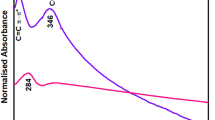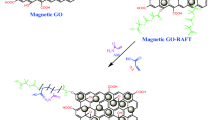Abstract
Graphene (GR) is a new type of carbon-based material that combines many excellent properties. In order to give full play to the excellent properties of graphene and expand its application scope, this study used ionic liquid SbF6 to modify it and successfully prepared ionic liquid modified graphene composites (H/GR), and studied its adsorption mechanism of arsenic in aqueous solution. By investigating the effects of reaction temperature, reaction time, pH, adsorbent (H/GR) dosage, and humic acid concentration on the removal rate of arsenic in aqueous solution, the experimental results showed that when the reaction temperature was 30 °C, reaction time was 1 h, pH was 6, H/GR dosage was 0.1g·L–1, and humic acid (HA) concentration was 10 mg·L–1, the best arsenic removal effect was achieved with a maximum. The removal rate was 99.4%. The equilibrium adsorption capacity was well modeled by the Langmuir, Freundlich, and Tenkin models at 30 °C. The Langmuir adsorption isotherm was the most consistent, with a calculated maximum value of 137.95 mg·g–1, which is higher than most adsorbents in the field. In addition, it was determined that the graphene surface was indeed immobilized with the ionic liquid [Hmim]SbF6 by SEM mapping and EDS energy spectroscopy observation, and the adsorption isotherms and pore size distribution maps of graphene before and after the loading of the ionic liquid were analyzed by BET, which further confirmed a significant increase in the microporosity and porosity of the modified H/GR, and furthermore, it was demonstrated that the arsenic ions are chemically bonded with and indeed adsorbed on the surface of the H/GR by FT-IR and XPS characterization analyses. The results of all experimental data studies indicate that the main mechanism of As(V) removal from water by H/GR is due to electrostatic adsorption, ion exchange, and complexation between the modified graphene itself and the ionic liquid [Hmim]SbF6 itself.














Similar content being viewed by others
Data availability
The datasets used and/or analyzed during the current study are available from the corresponding author on reasonable request.
References
Achanai Buasri NC, Vorrada LoryuenyongS Phatsakon Worawanitchaphong, Sarinthip Trongyong. (2013). Calcium oxide derived from waste shells of mussel, cockle, and scallop as the heterogeneous catalyst for biodiesel production. The Scientific World Journal,2013,(2013–12–18), 2013, 460923. https://doi.org/10.1155/2013/460923
Adams Udoji Itodo AU, Grace Akinrinmade, Happiness Ugbede Itodo, Vincent C. Ugboaja. (2012). Performance assessment of received and formulated carbon animalis: a comparative adsorption isotherm test. J Environ Protect, 3(3), 288–295. https://doi.org/10.4236/jep.2012.33036
Agusa TK, Reiji, Kunito T, Minh TB, Trang PTK, Chamnan C, Iwata H, Viet PH, Tana TS, Tanabe S (2007) Arsenic pollution in groundwater of Vietnam and Cambodia: a review. Biomed Res Trace Elem, 18(1), 35–47. https://doi.org/10.11299/brte.18.35
Barroso–Bujans F, R.–P. M., Saiz–Arroyo C; Verdejo R, Carretero–Gonzalez J,Lopez–Manchado MA. (2008) Macromolecular nanotechnology: physical properties of silicone foams filled with carbon nanotubes and functionalized graphene sheets. Eur Polym J, 44(9), 2790–2797. https://doi.org/10.1016/j.eurpolymj.2008.06.033
Carlo Di Giovanni, W.–A. W., Sophie Nowak, Jean–Marc Grenèche, Hélène Lecoq,; Ludovic Mouton, Marion Giraud, Cédric Tard (2014) Bioinspired iron sulfide nanoparticles for cheap and long–lived electrocatalytic molecular hydrogen evolution in neutral water. Acs Catalysis, 4(2), 681–687. https://doi.org/10.1021/cs4011698
Chetia MC, Soumya; Banerjee, Saumen;Nath, Manash J;Singh, Lokendra;Srivastava, Ravi B;Sarma, Hari P. (2011). Groundwater arsenic contamination in Brahmaputra river basin: a water quality assessment in Golaghat (Assam), India. Environmental Monitoring & Assessment, 173(1–4), p.371–385. https://doi.org/10.1007/s10661-010-1393-8
DJ Bian, Q. R., X Tian,YK Pan,LF Zhou. (2010). Process design scheme of treatment of non–ferrous metal smelting acid wastewater containing arsenic and iron. Environ Sci Technol, 33(5), 151–153. https://doi.org/10.1111/j.1744-7917.2010.01338.x
Elisa Bustaffa, F. M., Maria Grazia Andreassi, Simona Carone, Alessio Coi, Liliana Cori, Francesca Faita, Francesco Faita, Sabina Grecchi, Claudio Minoia, Anna Ronchi, Ivana Scovassi, Rosa Sicari, Francesco Stea, Fabrizio Bianchi. (2014). Studies on markers of exposure and early effect in areas with arsenic pollution: methods and results of the project SEpiAs. Epidemiological surveillance in areas with environmental pollution by natural or anthropogenic arsenic. Epidemiologia E Prevenzione, 38(3–4 Suppl 1), 27. https://doi.org/10.1080/00207230304732
Eun-Hyung Yoo H-JO, Lee S-Y (2008) Gallstone analysis using Fourier transform infrared spectroscopy (FT–IR). Clin Chem Lab Med 46(3):376–381. https://doi.org/10.1515/CCLM.2008.074
Felix SPSWLHRM (2007) Electrochemical oxidation of arsenites, by an anode of reticulated glassy carbon as previous step for removal. ECS Trans 3:61–76. https://doi.org/10.1149/1.2806951
Feng LC., ZI. (2008) Research progress on dissolution and functional modification of cellulose in ionic liquids. J Mol Liq, 142(1–3), 1–5. https://doi.org/10.1016/j.molliq.2008.06.007
Fenghui Wu, C. Z., Guangfei Qu,Zhoupeng Yan,Yingda Zeng, Bangjin Chen, Yinghui Hu,Wei Ji,Yingli Li and Huimin Tang. (2021). Adsorption of arsenic from aqueous solution using a zero–valent iron material modified by the ionic liquid [Hmim]SbF 6. RSC Advances(2), 6577–6585. https://doi.org/10.1039/D0RA09339D
Ferro, A. V. G. G. C. M. C. (2017). Application of scanning electron microscopy–energy dispersive X–ray spectroscopy (SEM–EDS). https://doi.org/10.1016/bs.coac.2016.1010.1002. https://doi.org/10.1016/bs.coac.2016.10.002
Fredericks, M. B. C. S. T. K. T. P. H. V. P. M. L. S. M. L. S. S. D. (2007). Magnitude of Arsenic Pollution in the Mekong and Red River Deltas–Cambodia and Vietnam. Science of the Total Environment, 372(2–3), 413–425. https://doi.org/10.1016/j.scitotenv.2006.09.010
G. Baraníková, J. M. (2003) The influence of humic acid quality on the sorption and mobility of heavy metals. Plant Soil Environ, 49(12), 565–571. https://doi.org/10.17221/4195-pse
Gottfried JM, Maier F, Rossa J, Gerhard D, Steinrueck HP (2006) Surface studies on the ionic liquid 1–ethyl–3–methylimidazolium ethylsulfate using X–ray photoelectron spectroscopy (XPS). Z Phys Chem 220(10):1439–1453. https://doi.org/10.1524/zpch.2006.220.10.1439
Hiroyuki Tokuda KH, Kunikazu Ishii, Abu Bin Hasan Susan, Masayoshi Watanabe. (2004). Physicochemical properties and structures of room temperature ionic liquids. 1. Variation of anionic species. The Journal of Physical Chemistry B, 108(42), 16593–16600. https://doi.org/10.1021/jp047480r
Hossein Shahbeig NB, Ghorbanian SA, Hallajisani A, Poorkarimi S (2013) A new adsorption isotherm model of aqueous solutions on granular activated carbon. World J Modell Simul 9(4):243–254
Huang, S. H. (2016). Study on pollution characteristics and effectiveness of heavy metals in soil of discarded around a lead and zinc mining area. Technological Development of Enterprise.
Ivan Andjelkovic, D. N. H. T., Shervin Kabiri, Sara Azari, Marijana Markovic, and Dusan Losic*. (2015). Graphene aerogels decorated with α–FeOOH nanoparticles for efficient adsorption of arsenic from contaminated waters. Acs Appl Mater Interfaces, 7(18), 9758–9766. https://doi.org/10.1021/acsami.5b01624
Jalil, A. A. T., Rnsugeng;Adam, Rns. Hazirah;Rahim, Rnn. Diana;Aziz, Rnm. Arif A.;Hairom, Nhh;Razali, Rnn. Aini M;Abidin, Rnmahani A. Z;Mohamadiah, Rnm. Khairul A. (2010). Adsorption of methyl orange from aqueous solution onto calcined Lapindo volcanic mud. Journal of Hazardous Materials, 181(1–3), 755–762. https://doi.org/10.1016/j.jhazmat.2010.05.078
Li Yang, M. D., Zoya Shahrivari, Mayur Ostwal, Paul K. T. Liu, Muhammad Sahimi, Theodore T. Tsotsis. (2006). Adsorption of arsenic on layered double hydroxides: effect of the particle size. Industrial & Engineering Chemistry Research, 4742–4751. https://doi.org/10.1021/ie051457q
Liu S (2015) Cooperative adsorption on solid surfaces. J Colloid Interface Sci 450:224–238. https://doi.org/10.1016/j.jcis.2015.03.013
Motoi Machida TM, Tatsumoto H (2006) Lead(II) adsorption onto the graphene layer of carbonaceous materials in aqueous solution. Carbon 44(13):2681–2688. https://doi.org/10.1016/j.carbon.2006.04.003
Nahar N (2009) Impacts of arsenic contamination in groundwater: case study of some villages in Bangladesh. Environ Dev Sustain 11(3):571–588. https://doi.org/10.1007/s10668-007-9130-3
Olajire AA, Giwa A, Bello IA (2013) Adsorptive removal of methylene blue dye by melon husk: kinetic and isothermal studies. Pakistan J Sci Industr Res Ser a: Phys Sci 56(3):151–164. https://doi.org/10.52763/PJSIR.PHYS.SCI.56.3.2013.151.164
Qu GL, Rui; Zhou, Yanan; Wu, Bin;Cai, Yingying;Ning, Ping. (2019). Preparation of ferric nitrate–graphene nanocomposite and its adsorption of arsenic(V) from simulated arsenic containing wastewater. Appl Organometallic Chem, 33(11), e5221. https://doi.org/10.1002/aoc.5221
Rodionov, V. K. K. m. M. V. N. N. G. B. N. V. (2007). Geological structure, composition, and age of the Pyalochnoozero ultramafic–mafic massif, northeastern Baltic Shield. Doklady Earth Sci, 413(2), 173–177. https://doi.org/10.1134/S1028334X07020067
Shahid MN, Nabeel Khan, Dumat, Camille, Naidu, Ravi, Khalid, Sana, Rahman, Mohammad Mahmudur, Bibi, Irshad. (2018). A meta–analysis of the distribution, sources and health risks of arsenic–contaminated groundwater in Pakistan. Environmental Pollution, 242(PT.A), 307–319. https://doi.org/10.1016/j.envpol.2018.06.083
Shunai Che KL, Tatsumi T, Iijima S, Joo SH, Ryoo R, Terasaki O (2003) Direct observation of 3D mesoporous structure by scanning electron microscopy (SEM): SBA–15 silica and CMK–5 carbon. Angew Chem 42(19):2182–2185. https://doi.org/10.1002/anie.200250726
Smith E, Naidu R (2009) Chemistry of inorganic arsenic in soils: kinetics of arsenic adsorption–desorption. Environ Geochem Health, 31(suppl.1), 49–59. https://doi.org/10.1007/s10653-008-9228-z
Sudipta Sarkar JEG, Gupta A, Uy D, SenGupta AK (2012) Sustainable engineered processes to mitigate the global arsenic crisis in drinking water: challenges and progress. Annu Rev Chem Biomol Eng 3(1):497–517. https://doi.org/10.1146/annurev-chembioeng-062011-081101
T, W. (2004). Ionic liquids in catalysis. Coordination Chemistry Reviews, 248(21–24), 2459–2477. https://doi.org/10.1016/j.ccr.2004.04.015
Tang, B. D., Jiannan, Feng, Qingmao, Zhang, Jiaqi, Wu, Dan, Jiang, Xiankai, Dai, Ying, Zou, Jinlong. (2018). Enhanced generation of hydroxyl radicals on well–crystallized molybdenum trioxide/nano–graphite anode with sesame cake–like structure for degradation of bio–refractory antibiotic. J Colloid Interface, 517, 28–39. https://doi.org/10.1016/j.jcis.2018.01.098
Wang, L.–m. (2005) Chronic arsenic poisoning caused by long–term taken Niuhuang Ninggong tablet: a report of 2 cases. Chinese Journal of Integrated Traditional and Western Medicine, 25(3), 213. 15842139
Y Wang, P. H., Y Lu,L Xiao,S Ye. (2019). Removal of arsenic and heavy metals from arsenic containing acid wastewater with iron salt and lime. Environmental Engineering and Management Journal, 18(12), 2655–2662. https://doi.org/10.30638/eemj.2019.250
Y.Yano;, K. I., A.Kodama, K.Shiomori,S.Tomomatsu, M.Sezaki,H.Yokota. (2012). Arsenic polluted groundwater and its countermeasures in the Middle Basin of the Ganges, Uttar Pradesh State, India. Journal of Environmental Protection, 03(8), 856–862. https://doi.org/10.4236/jep.2012.328100
Zhang SJ, S. N., He XZ, Lu, XM,Zhang, XP. (2006). Physical properties of ionic liquids: database and Evaluation. J Phys Chem Ref Data, 35(4), 1475–1517. https://doi.org/10.1063/1.2204959
Zhongqiu Luo, W. M., Xintao Zhou,Zhuo Chen. (2021). Removal and immobilization of arsenic from wastewater via arsenonatroalunite formation. Environmental Technology, 1–25. https://doi.org/10.1080/09593330.2021.1908428
Zhou, L. Y., JY; Yuan, WZ; Zhou, M; Wu, SZ; Li, ZL; Xing, XH; Shen, DZ. (2009) Synthesis and characterization of multi–functional hybrid magnetite nanoparticles with biodegradability, superparamagnetism, and fluorescence. Materials Letters, 63(18–19), 1567–1570. https://doi.org/10.1016/j.matlet.2009.03.030
Funding
This study was supported by the National Natural Science Foundation of China under the project “Microscopic behaviour of heavy metal migration transformation in Pb–Zn tailings and its nano–microscopic highly oriented stabilization mechanism” (51968033) and the National Key Research and Development Program of China under the project “Environmental functional materials, technology and equipment for long–term solidification/stabilization of heavy metal tailing pollution” (2018YFC1801702), and is gratefully acknowledged.
Author information
Authors and Affiliations
Contributions
We acknowledge that all the authors contributed to this paper, including sampling, data collection, data processing, mapping, and research rationale. Corresponding author Professor Qu Guangfei guided our research route and writing; author Li Yingli participated in data recording and data processing, mapping, and other related work during the study; authors Xiang Keyi and Li Rui provided assistance in experimental methods and mechanistic analysis. All authors read and approved the final manuscript.
Corresponding author
Ethics declarations
Ethics approval and consent to participate
This article does not contain any studies with animals or human participants performed by any of the authors.
Consent for publication
Not applicable.
Conflict of interest
The authors declare no competing interests.
Additional information
Responsible Editor: Guilherme Luiz Dotto
Publisher's Note
Springer Nature remains neutral with regard to jurisdictional claims in published maps and institutional affiliations.
Rights and permissions
Springer Nature or its licensor (e.g. a society or other partner) holds exclusive rights to this article under a publishing agreement with the author(s) or other rightsholder(s); author self-archiving of the accepted manuscript version of this article is solely governed by the terms of such publishing agreement and applicable law.
About this article
Cite this article
Li, Y., Xiang, K., Qu, G. et al. Preparation of ionic liquid modified graphene composites and their adsorption mechanism of arsenic (V) in aqueous solution. Environ Sci Pollut Res 31, 16401–16412 (2024). https://doi.org/10.1007/s11356-024-31830-3
Received:
Accepted:
Published:
Issue Date:
DOI: https://doi.org/10.1007/s11356-024-31830-3




